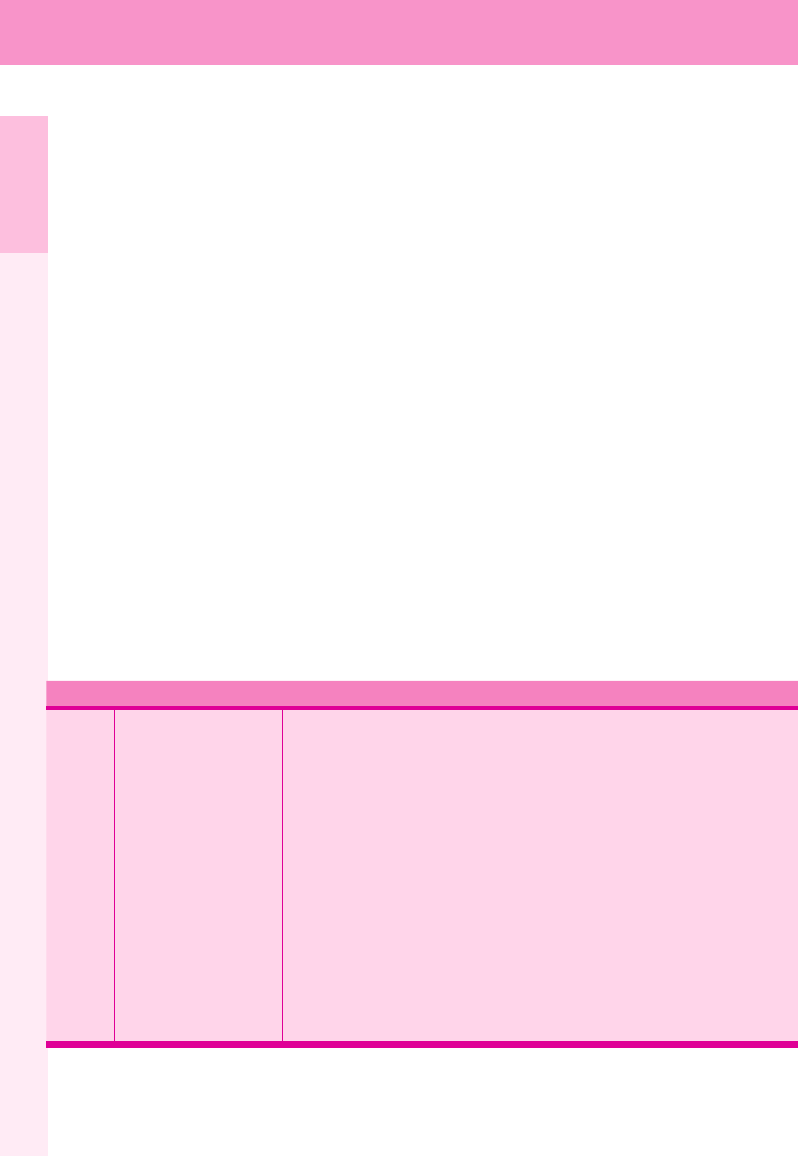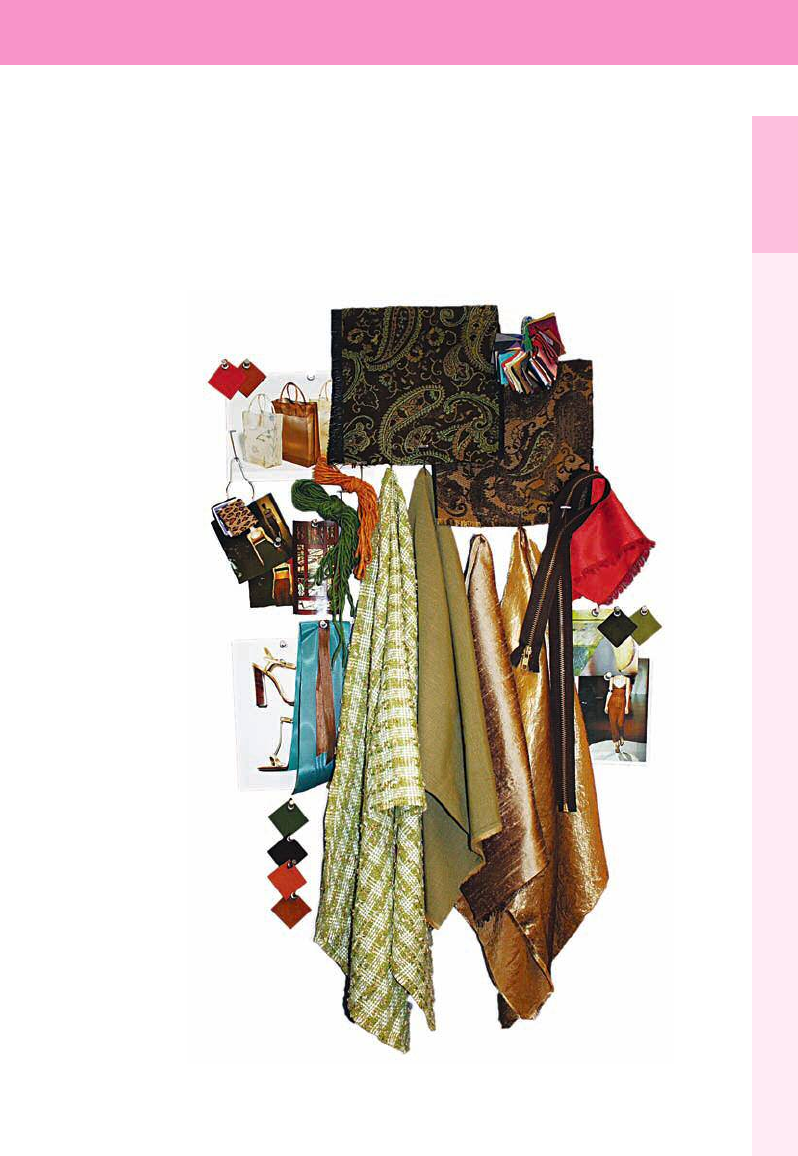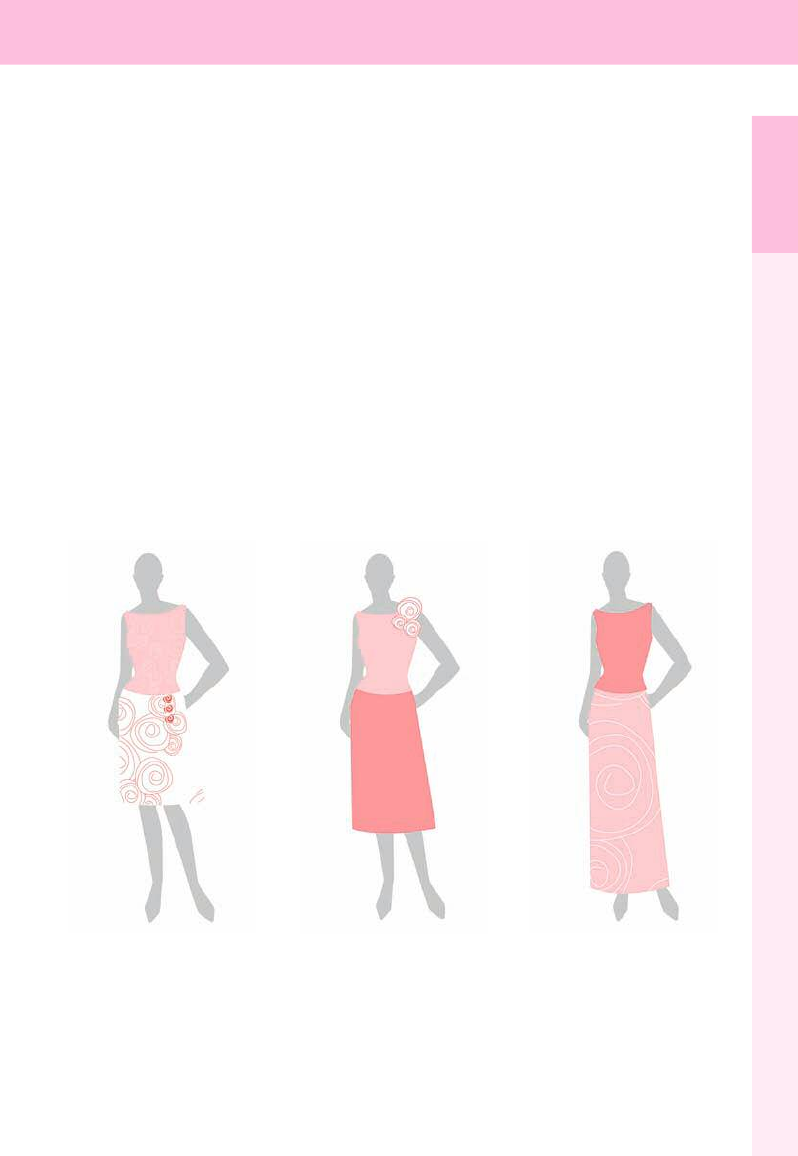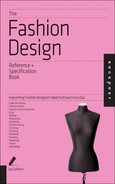
Job:12-29742 Title:RP-Fashion Design Ref and Spec Book
#175 Dtp:204 Page:20
020-025.indd 20 2/26/13 7:29 PM
2 0 THE FASHION DESIGN REFERENCE + SPECIFICATION BOOK
(Text)
Chapter 2: Collection Theory
With a little creativity and a basic grasp of how a garment is constructed, many
people will dabble in fashion and fancy themselves designers. With enough
time, they might even accumulate a collection of garments. Certainly, their
work might be an artistic accomplishment, but it does not address what the
industry expects from the fashion designer each season. Designers are asked,
above all, to translate a design philosophy into an evolving series of collec-
tions that speaks to their customers during every fashion cycle. A collection
is a group of garments conceived and designed, released and marketed, for a
particular season by a design house.
RESOURCE FILES
Category Subcategories
Fashion
Accessories
Beauty
Swatches
Silhouette
Art
Culture
Technology
Transportation
Daywear, eveningwear, menswear, outerwear, athletic apparel
Shoes, bags, jewelry, hats, eyewear, hosiery, belts, gloves
Models, hair, makeup, tattoos, piercing, fitness
Color, texture, pattern, decoration, fastenings
Architecture, furniture, plant life, animals, science
Painting, drawing, photography, sculpture, dance, theater
Folk art, television, film, animation, music, celebrity
Internet, blogging, communication devices, music players,
hardware
Cars, motorcycles, bicycles, boats, trains, airplanes
M
A
If
s
c
o
to
ACCESSING INSPIRATION
An artist may spend time courting the muse, but a fashion designer seldom has the luxury of
waiting for inspiration to strike. Accessing the creative mind is simple if one fuels the source
on a regular basis. Designers must train themselves to collect tear sheets from magazines
and printouts from websites, as well as swatches of colors and textiles, and to keep note-
books of written ideas and sketches. Whatever form they take, these resource files should be
maintained and organized for easy retrieval when trying to stimulate the imagination. Beyond
fashion images, they should include material drawn from art, technology, science, graphics,
architecture, advertisements—in other words, anything that triggers a response.
02
Job:12-29742 Title:RP-Fashion Design Ref and Spec Book
#175 Dtp:204 Page:20
020-025.indd 20 2/26/13 7:29 PM

Job:12-29742 Title:RP-Fashion Design Ref and Spec Book
#175 Dtp:204 Page:21
Book
ge:20
020-025.indd 21 2/26/13 7:29 PM
21
(Text)
Mood Boards
A useful way to assemble the many inspirational components of a collection is a mood board.
If space allows, a designer can place all the elements of the resource file—fabric swatches,
sketches, photographs, buttons, trim, tear sheets, and printouts—on a bulletin board or foam
core. In some studios, the assemblage can take over an entire wall. Smaller versions are easy
to compile as collages and flip books.
e
02
Job:12-29742 Title:RP-Fashion Design Ref and Spec Book
#175 Dtp:204 Page:21
Book
ge:20
020-025.indd 21 2/26/13 7:29 PM

Job:12-29742 Title:RP-Fashion Design Ref and Spec Book
#175 Dtp:204 Page:22
020-025.indd 22 2/26/13 7:29 PM
2 2 THE FASHION DESIGN REFERENCE + SPECIFICATION BOOK
(Text)
THEMES
Themes provide fashion designers with a lens through which they can focus on a particular de-
sign challenge. Continuing the metaphor, a camera will do the job it was created to do, so long
as the person holding it can meet the minimum requirements of pointing it in the direction of
the subject and releasing the shutter by pressing down on a button. More times than not the
result will be exactly what one would expect: an acceptable image. Similarly, someone with a
fundamental understanding of how a sewing machine works can put together a garment.
But simply addressing the basic needs that a particular garment must satisfy is not design. A
fashion designer is called to take the creation of an article of clothing to another level. Once
research has led to inspiration, the designer develops and tests formulas in the design room.
The result is a unique theme that bears the signature of how that designer has chosen to
solve the design equation. And this is what a customer ultimately buys into.
Referencing Periods
When embracing any theme, the designer must take special care not to risk duplication. A con-
cept may incorporate Victorian design elements, but should not translate these details literally
if the designer is truly looking to innovate. Doing so results in the re-creation of historical
garments that may still be relevant today, keeping in mind that the business of fashion does
have a large percentage of “stylist” designers. This type of designer reproduces tried-and-true
garments with modi cations that relate to current trends and tastes. The work usually involves
a certain amount of interpretation that allows it to go beyond mere replication. Without inter-
pretation, the outcome speaks more to costume design than to fashion.
The Hollywood Pitch
To communicate the idea behind a new movie project Hollywood executives might pitch their
projects using well-established references that are both familiar and have a successful track
record. These associations provide a level of comfort and accessibility. Referencing multiple
sources of inspiration becomes a way to infuse the idea with a fresh perspective.
A fashion designer faced with the prospect of developing a collection for teens could look to
popular cultural associations. An X-meets-Y approach can get things started. For one designer,
“Harry Potter meets High School Musical” might conjure up images of British kids in school uni-
forms and mythical winged creatures, all set to perky teen music. Add a twist like Star Wars:
The Clone Wars, and the mix now encompasses space travel references and anime-inspired
style lines. The combination of recognizable components and an unpredictable path will be
fertile ground for novelty, if not invention.
C
T
In
b
e
ch
a
d
S
A
a
ra
b
b
D
S
w
a
r
de
02
Job:12-29742 Title:RP-Fashion Design Ref and Spec Book
#175 Dtp:204 Page:22
020-025.indd 22 2/26/13 7:29 PM

Book
ge:22
Job:12-29742 Title:RP-Fashion Design Ref and Spec Book
#175 Dtp:204 Page:23
020-025.indd 23 2/26/13 7:29 PM
Collection Theory 2 3
(Text)
e-
g
A
n-
ly
e
s
r,
i-
COLLECTION DEVELOPMENT
The Menu
In the process of developing a collection, the designer must turn to a checklist of design
building blocks to ask what silhouette, line, patterns, texture, colors, and decoration will be
employed. The answers become the fixed menu of options for the project, and a designer’s
choices will directly influence how harmonious (or intentionally discordant) each component
appears in any ensemble. Beyond pulling from this bill of fare for individual ensembles, the
designer must clearly visualize how these elements will all work together as a collection.
Scale
Aspects of core themes should be explored at various scales to uncover every possible
application. By finding multiple ways to deliver their message, designers can reach a wider
range of consumers likely to identify with a particular facet of the concept. Not everyone would
be immediately receptive to a “rose” theme, for example; a narrow definition might constitute a
barrier to interest. The diligent designer will consider different modes of interpreting the flower.
Overscale (maxi)
Fabric is printed with an image
of roses so big that it be-
comes abstract when wrapped
around the body.
Detail (mini)
Small buttons embossed
with the shape of a rose
are used as a functional
detail.
Three dimensional (midi)
A silk rose manufactured as a
literal expression of the theme is
used as decoration.
02
Book
ge:22
Job:12-29742 Title:RP-Fashion Design Ref and Spec Book
#175 Dtp:204 Page:23
020-025.indd 23 2/26/13 7:29 PM

Job:12-29742 Title:RP-Fashion Design Ref and Spec Book
#175 Dtp:204 Page:24
020-025.indd 24 2/26/13 7:29 PM
24 THE FASHION DESIGN REFERENCE + SPECIFICATION BOOK
(Text)
Center of Interest Detailing
A well-de ned center of interest is the rst place on a garment where one connects with a
designer’s message. How the center of interest is handled sets the tone for the collection. A
small detail like decorative buttons on an otherwise plain suit can provide a subtle center of
interest. esigns that feature busy patterns and heavy ornamentation are apt to melt into a col-
lage of details, making the overall silhouette the focus.
E
W
th
th
s
u
a
p
S
M
in
ti
a
a
L
B
fa
b
a
Expected: A blouse whose V-shaped opening
is trimmed with a double row of ruf es to
accentuate the neckline.
Unexpected: A little black dress with a high
neck and long tted sleeves that turns to
reveal a plunging back neckline.
Camou age : An A-line tunic with high side
slits worn over narrow trousers to create
uid unrestricted movement at the hip.
The Re ve al: A classic tailored tweed suit that
opens at the wearer’s discretion to reveal a
wildly colored print lining.
Using similar but related detailing, such as gathers, these four garments create contrasting
silhouettes and attract the eye to different parts of the body.
02
Job:12-29742 Title:RP-Fashion Design Ref and Spec Book
#175 Dtp:204 Page:24
020-025.indd 24 2/26/13 7:29 PM
..................Content has been hidden....................
You can't read the all page of ebook, please click here login for view all page.
